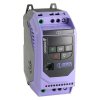Thanks BGB, that makes a lot of sense, I'll give it a go and see what I find.
Please excuse my ignorance. Is there a big difference between single and three phase, other than the winding setup that is (ie one is higher speed, other is higher torque), or are they just diffent ways of doing the same thing?
between single phase and brushed DC:
main obvious difference between them is that a single phase motor will always go the same direction (regardless of input polarity), whereas with DC motors, the direction depends on the polarity of the voltage applied. note that in many applications (where electronic controls are needed for the motor, such as in many appliances) high-voltage DC is fed to the motor, rather than AC (IOW: mains power fed through a rectifier, then transistors are used to drive the motor).
their main advantage is simpler electronics, basically, you give them power and they go.
they are good in cases where accurate speed control (under variable loads), wide operating range, and positioning aren't as high of a priority.
electronic controls are also easier with DC than with AC.
with 3 phase (and BLDC):
it is possible to have more precise speed (and position) control, either running lock-step with the mains power (typically requires a 3 phase power connection), or controlled via a motor driver and microcontroller (often called BLDC / Brushless DC in this case, where you can either use them like a stepper motor, or run them at higher-speeds while maintaining a specific RPM, or combinations thereof).
also unlike a single phase AC motor, it is possible to run the motor in either direction (well, unless you dynamically switch the field coil polarity or similar).
however, running a 3-phase motor off of DC or a single-phase power-source generally requires using electronic controls. a delta-wound motor will require a triple H-bridge to run it, whereas a wye-wound motor can use either a triple or quadruple H-bridge (for high torque operation), or can be run in a unipolar configuration, such as by connecting Vcc to common, and using pulldown transistors for each winding.
the usual advantage of delta windings is that they can be run at higher speeds, whereas wye has a wider operating range and allows higher torque.
it is also possible to control speed and torque independently, and run the motors at very low RPM with maintaining high torque (without needing to use gear reduction or a transmission), as the motors' speed is controlled by the phase frequency rather than the voltage (normal brushed motors have a certain minimum speed, and will stall below this point).
for example, the same motor can operate anywhere from 10 RPM to 20,000 RPM, and very accurately change speeds over a large range with the controller at the same time knowing exactly how far the motor has moved.
between BLDC and steppers:
steppers tend to be more designed for high-precision low-speed operation, but generally are fairly limited in terms of maximum RPM;
BLDC motors have a higher range, but tend to be less precise.
for example, a stepper can hold a position of 1/200 or a turn, but be limited to only around 600RPM;
whereas a BLDC motor can easily spin up to 10,000 RPM or more, but may be only have 6 or 12 steps per revolution (microstepping may help though).
also steppers and BLDC motors have different drive patterns.
steppers tend to have 4 or 6 wires and be square. they will generally consist of two separate windings (A and B), with the 6 wire variants having a connection to the mid-point of each winding.






